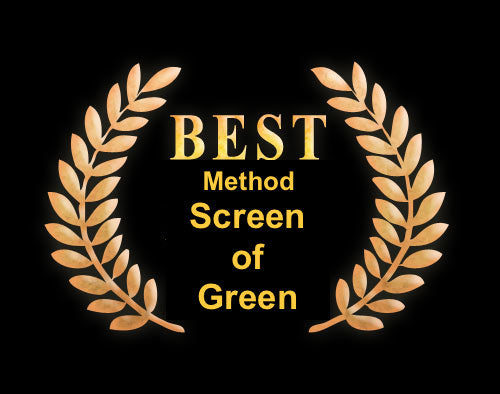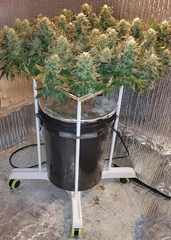The Best Supporting Method

And The Best Supporting Method Goes To…
Screen of Green, For Its Starring Role In Marijuana Gardens Everywhere!
In our first article in this series, we outlined the screen of green technique and its pros and cons.
To recap, screen of green, or SCROG, was created by growers working with limited ground space and/or vertical height in their garden area. It’s useful for small spaces, and in situations when a grower can only grow a few plants.
SCROG growers train their plants’ branches to grow into and along a horizontal support screen that’s suspended above the plants.
Training the plants, known as low stress training, or LST, creates plants with multiple main branches that yield more bud weight. This form of marijuana growing is especially useful for maximizing yield per harvest.
The key component of a SCROG garden is the screen itself, which consists of a flat support structure to allow for horizontal mounting of screen material such as netting or string.
Two main types of screening apparatus have been popularized for SCROG cannabis cultivation. One type is fixed in place and mounted over a cannabis gardening system that might be a grow table, ebb and flow table, or deep water culture bucket system.
Multiple plants grow under the screen; their branches are woven or otherwise fastened to the horizontal screen.
Meet Scrogger, Innovators From The Lone Star State
Instead of that approach, we recommend the second style of SCROG cultivating, which involves having an individual plant in its own grow container served by its own apparatus.
This kind of growing is facilitated by the P SCROG system made by Scrogger, a company headquartered near Austin, Texas.
Scrogger specializes in SCROG gardening and has created state-of-the-art, multilayered, adjustable screen kits to fit almost any SCROG garden size or style.
P SCROG by Scrogger features a height-adjustable apparatus, several screen options, and a base that can support up to 250 pounds of weight. Said base is mounted on casters so the entire system and the plant within it can be rotated in a complete circle, and can be easily moved to another part of the grow operation.
This mobility and ease of access erases the disadvantages of SCROG gardens that have several plants growing under and sharing a large fixed screen, including difficulty with watering, trimming, even accessing the lowest parts of the plants in the middle of the arrangement.
Margo Mermelstein co-founded Scrogger in 2015 along with her husband Gary. The family-run business owns the patent for its revolutionary gadget that now sells nationally, as well as in Australia and Canada.
Margo explains, “Our unique selling point is the screens. They are, if you will, our secret sauce, because they are clear, flexible, reusable — and that’s what people like. Whether growers are using our portable units or the 2×4 or 4×4 [units], which are not portable, we’re finding the commonality that runs through all of it is our unique screen.”
Scrogger screens are made from polycarbonate, with an impressive flex strength of 13,500 PSI. You can almost bend this material in half and it won’t break.
They’re built to resist degradation factors common in indoor marijuana gardens such as water, nutrients, ultraviolet light and heat. They’re nonporous, washable and food-grade, meaning the polycarbonate doesn’t contain any dyes or recycled plastic that’s harmful to humans. In addition, the food-grade designation means no other harmful chemicals were used in either the resin or in production of the plastic container.
This is in contrast to materials commonly used as screens, supports and trellising in SCROG gardens. Growers often resort to DIY methods for constructing SCROG apparatus. Some SCROG growers use metal wire, string, cheap plastics, wood, PVC pipe and conduit for their plant supports. These materials cause a variety of problems including off-gassing, unstable supports, sagging, disease vectors, and transfer of harmful toxins into the plants.
Scrogger systems eliminate those issues. They’re elegantly engineered plug-and-play tools created specifically for serious growers, and can be customized to fit your budget and your needs.
Such patented systems allow maximum versatility as growers train their plants, because the gadgets can be precisely height adjusted as plants grow, and the systems also allow for stacking secondary screens above the primary training screen that sits closest to the root zone.
Check out the below YouTube video to see how to assemble a Scrogger system.
“[The screen is] great for people who have smaller number of plants, 12 or less, so they can turn them around, trim them — do all kinds of things, including adjust the screen’s height as the plant grows,” Margo continues.
“People who get up into 50 plants or more are looking to use our screens by themselves in higher configuration. It really depends on the individual and what they’re doing for their grow.
“Plus it’s great for people who are handicapped, because it gives them more flexibility.”
When you have a SCROG unit encasing each plant individually, the grower is afforded full access and is likely to enjoy superior gardening outcomes.
We recommend Scrogger because the engineering and materials are top-rank, and because the company’s customer service is excellent, as is it unusually comprehensive product warranties.
Especially for marijuana growers who haven’t cultivated crops with SCROG before, the Scrogger systems are much easier to assemble and use than other pre-fabricated or DIY plant support systems. These systems give you the ability to more easily and quickly maximize the benefits of this style of marijuana growing.
In our next articles about SCROG, we’ll take a deep dive into LST, as well as customized grow lighting, root zone and feeding techniques.

P SCROG Kits
or
SupportOurPlants@SCROGGER.com
- Gary Memelstein
